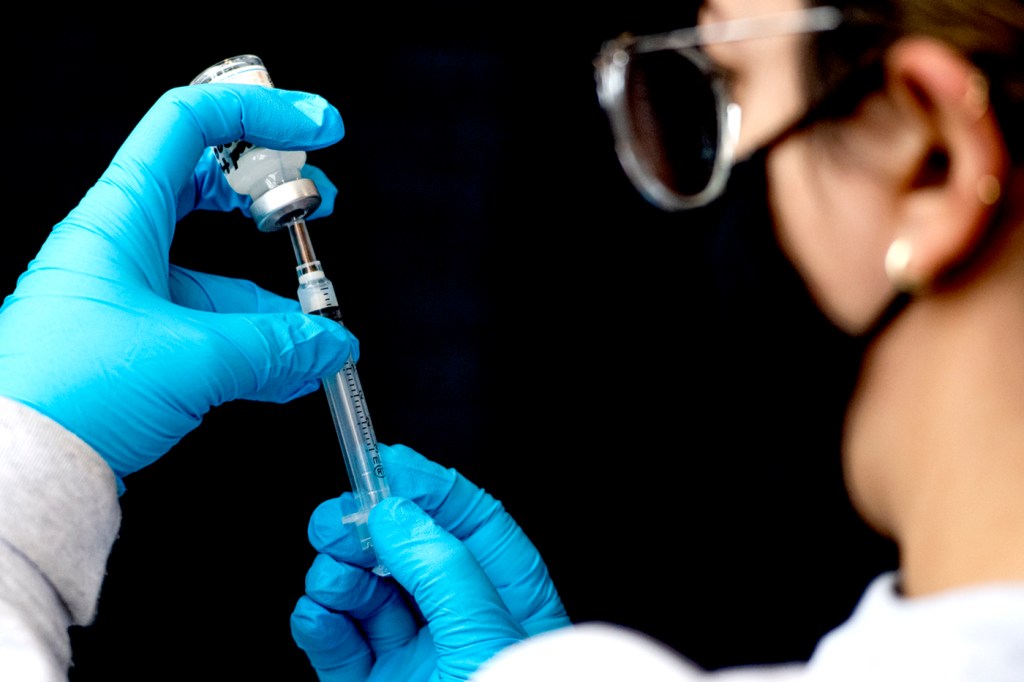How does the COVID-19 vaccine help us reach herd immunity?

On Monday, all adults over the age of 16 became eligible for a COVID-19 vaccine. But just last week, the U.S. Centers for Disease Control and Prevention and U.S. Food and Drug Administration announced a pause of the Johnson & Johnson vaccine—the one-shot option—after six reports of blood clots emerged. As adults across the nation sign up for their vaccine appointments, questions still linger: What does the pause in the Johnson & Johnson vaccine mean? How will it affect vaccine hesitancy? And what should you expect when you finally get your vaccine?
Amid the pause in the distribution of the Johnson & Johnson vaccine and widespread vaccine hesitancy, it’s important to maintain confidence in the overall vaccine rollout process in order to reach herd immunity, say Brandon Dionne, assistant clinical professor of pharmacy and health systems sciences, and Neil Maniar, professor of the practice and director of the Master of Public Health program.
Let’s start with the big news last week—the CDC and FDA announcement about the Johnson & Johnson vaccine. We keep hearing the word pause. What exactly does a pause mean?
Brandon Dionne: This pause is a temporary hold on administering the Johnson & Johnson vaccine while we further investigate these case reports of blood clots. It’s giving the experts an opportunity to look at the cases and try to determine whether or not [the blood clots are] actually caused by the vaccine. It seems to be incredibly rare right now, but as people become more aware of it, we may start to see a few more cases be reported. The hope is that eventually we’ll come out of this with some more guidance and criteria on who still should be eligible for the Johnson & Johnson vaccine.
It’s helpful to know how often pauses happen and how long they usually last. Neil, can you speak to that? What should we know about these pauses and how common are they?

Left, Neil Maniar, director of the Master of Public Health program and a professor of the practice in the Bouvé College of Health Sciences. Right, Brandon Dionne, assistant clinical professor of pharmacy and health sciences in the Bouvé College of Health Sciences. Photos by Matthew Modoono/Northeastern University
Neil Maniar: There’s no set time frame; these pauses tend to be fairly rare and when they do happen, it really varies from one situation to the next in terms of how long that pause will last. The indications from the CDC, from Dr. [Anthony] Fauci, and others seem to be that this current pause with the Johnson & Johnson vaccine will probably last days or potentially a few weeks, but it’s unlikely that it’s going to last for several months. I tend to believe this is a good thing in the sense that it shows that the system works.
It shows that there’s a real focus on ensuring that we are paying attention to the continued safety and efficacy of these vaccines. All of the vaccines that have received the Emergency Use Authorization have been shown to be safe and efficacious. The clotting events that have occurred have been exceedingly rare, but they have sparked a further inquiry, which is a good thing because that’s what we want to be doing during this period of EUA approval for the vaccines.
We’ve used the word ‘rare’ a few times. Can we talk a little bit about what exactly ‘rare’ means relative to how these six cases play into the larger pool of recipients of the Johnson & Johnson vaccine?
Brandon Dionne: There have been over seven million doses of the Johnson & Johnson vaccine administered in the U.S., and so far we’ve only had six reported cases [of blood clots]. We may start to see an increase in that number as people become more aware of this. The major concern in the cases that have been recorded [is that the] clot is in the brain, which is very serious and requires different treatment than a normal clot. We have monitoring in place to try to identify these cases. Regardless, it’ll be a very rare event. There’s about a one in a million chance [of getting a blood clot]. It would probably go up a little bit from there, maybe one in the hundred thousands.
But when you compare that to some other medications that are commonly used, [other medications] have a much higher rate of clotting. Oral hormonal contraceptives, for example, are widely used. So while the risk is very serious, it is also very, very uncommon and highly unlikely to occur.
What about the Johnson & Johnson option might make it more attractive than its counterparts?
Brandon Dionne: It’s a single dose, so there’s no need for follow-up. The Johnson & Johnson vaccine only has to be refrigerated; it doesn’t have to be frozen like the Moderna and Pfizer vaccines. So it’s more stable, it’s easier to get into resource limited areas. Also because of that single dose, it has fewer adverse effects. Patients who are already potentially concerned about the adverse effects were excited about that potential with the one dose and fewer side effects. Within the U.S., I think there’s a role [for the Johnson & Johnson vaccine], especially in lower and middle income countries.
The weighing of that personal decision, of getting the vaccine, makes me think of conversations about vaccine hesitancy. What can you say now about skepticism and hesitancy across the U.S.?
Neil Maniar: The issue of vaccine hesitancy is real, and it is a significant barrier to achieving herd immunity for all of us—both as a country and within our own local communities. There are several key things that are important to recognize in terms of vaccine hesitancy, especially as we think about vaccine hesitancy on a national level. One of the important components of vaccine hesitancy is the fact that there are really strong historical underpinnings to vaccine hesitancy in certain communities that have created a strong distrust with the healthcare system and the clinical research system. It’s important for us to address that. As we educate communities about the vaccines, we [should] approach this from the perspective of health literacy and make sure that information is accessible to everyone—that we’re able to translate information into different languages and really make sure that it is reaching everyone.
It’s also important that we are absolutely honest and transparent in these conversations. We’re in the midst of a continually evolving pandemic. As we’re finding out right now, just as folks are starting to see the light at the end of the tunnel, there’s talk of a fourth wave and there are certain areas of the country that are experiencing a significant surge. We need to remain vigilant. We need to talk about what’s going on.
Another piece is really focusing on those groups that are demonstrating higher levels of vaccine hesitancy. Certainly within certain racial and ethnic groups we’re seeing this. But also in certain age groups, when we look at younger populations and the proportion of younger populations who are saying that they don’t intend to get the vaccine because they feel like they don’t have to worry about COVID-19. Or they don’t have to worry about being hospitalized, or developing severe illness from COVID-19. There are many different components, but I think some of the most important solutions to vaccine hesitancy are about honesty and transparency and accessibility of the information around it.
How could this specific pause of the Johnson & Johnson vaccine impact overall vaccine hesitancy?
Brandon Dionne: If anything, this pause should increase the confidence in the vaccines because it shows that the FDA is committed to monitoring this as an ongoing basis. From just six cases, they were able to identify this and responded immediately with the pause to try to further investigate and see what the real risk of this is and if we should adjust our recommendations based on it. While I certainly understand that people could be afraid of the potentially serious side effect of a brain clot, it really should instill confidence in the process that we are monitoring this. We’re looking for these safety signals and we’re making people aware of them as soon as we identify them and we’re responding appropriately.
There are plenty of folks who’ve already received this vaccine. What would you say to them? What should they know now as they’re keeping up with the news?
Neil Maniar: If you received the Johnson & Johnson vaccine more than two weeks ago, you should be fine now. The important thing is to understand what the signs and symptoms are of clots. If you do exhibit any of those symptoms, contact your healthcare provider. Understand that these are exceedingly rare events—seven million people have received this vaccine so far, and there have been six cases. So 6,999,000 folks have done OK.
Brandon Dionne: I totally agree. You might experience some side effects from the vaccine in that immediate, 24-hour to 48-hour period, and the incidents of the clots are not within that period. [Clots typically occur] within that five to 15-day window. So, if you have adverse effects right after you received the vaccine, that is unlikely to be associated with any sort of clot. But if you do have symptoms in that 5- to 15-day period like headache, blurred vision, slurred speech, like symptoms that you’d see with a stroke, that could be a concern for a brain clot. Having pain or inflammation in your lower extremities or trouble breathing could be signs of other types of clots that haven‘t been as closely associated.
Obviously, time is of the essence as we continue the vaccine rollout, especially with the onset of new variants. What sort of timeline are we working with here?
Neil Maniar: It’s important to recognize that variants are common with this type of outbreak, but they also underscore why it is so important for everyone to get vaccinated. Variants are a byproduct of viral replication and as these viruses continue to replicate, mutations will occur. The vaccines that we currently have available through Emergency Use Authorization have all shown to be effective to some degree, or in some cases to a significant degree, against several, if not all of these current variants that we are aware of. The vaccines produce a pretty robust immunological response, and that response is going to provide some degree of protection against the variants.
We really want everyone to get vaccinated, because the closer that we can get toward achieving herd immunity, the less likely it will be that we will have these outbreaks that lead to additional variants forming. We really want to contain that, and the way to contain that is by ensuring that as many people get vaccinated as possible and to really dispel this idea that the current vaccines are useless. The fact that these variants are currently present further underscores the importance of getting the vaccinations and further underscores the importance of those vaccinations as a whole.
For folks who have scheduled their vaccine appointments, what should they expect? How can they prepare and what will it look like for them?
Brandon Dionne: People that were scheduled for the Johnson & Johnson vaccine obviously had appointments canceled. It actually happened to my parents. Hopefully there’ll be a good process in place to reschedule.
For people scheduled for the Moderna or Pfizer, that first dose for most people is very well tolerated because they don’t have that antibody response yet. You might have some localized pain, but it’s more rare with the first shot. It’s that second dose, either three weeks later for Pfizer or four weeks later for Moderna, where people tended to have more severe adverse reactions, or not. It could be something as simple as fever, injection site pain, or fatigue. You can generally overcome those by taking NSAIDs like ibuprofen or Tylenol. We want to make sure you don’t take those before you get the vaccine, because there’s some concern that it may reduce the immune response to the vaccine. But if you have symptoms after the fact, you certainly can take them to try to deal with those symptoms.
Neil, you speak frequently about the importance of protective measures like masking, distancing, and surveillance testing. Why is all of that, which we’ve gotten down a year in, still so important?
Neil Maniar: The pandemic has truly been a marathon. In some ways, while the finish line to this marathon is not too far away, we still have Heartbreak Hill ahead of us. We still have some tough phases of this marathon ahead of us. In order to get to the finish line, in order for all of us to emerge from this pandemic, we do need to continue to practice the same degree of vigilance that has gotten us through the pandemic to this point. It’s important for all of us to wear masks because we know that the current vaccines do not offer 100% protection. We want to make sure when we’re outdoors or when we’re around others, especially those who have not been vaccinated or those who are at high risk for developing severe illness from COVID-19, that we wear a mask because individuals could be asymptomatic carriers of COVID-19, even though they’ve been vaccinated.
That mask usage will also help us contain the spread of potential variants or reduce the likelihood that other variants will emerge. Testing, similarly, is going to continue to be important. We want to make sure that we understand the continued prevalence of COVID-19 in our communities.
It’s really about keeping ourselves safe and keeping others around us safe. The pathway to emerging from this pandemic is both an individual one and a collective one. The way that we will all get on the other side of this is by making sure that we continue to look out for one another.
For media inquiries, please contact media@northeastern.edu.





